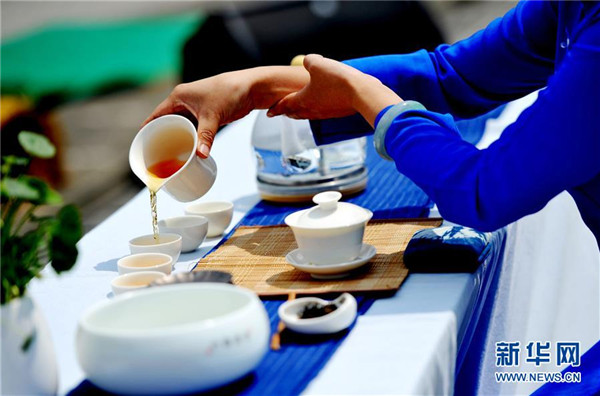


A tea art master brews tea during the competition held in Liping county on May 16. [Photo by Yang Daifu/gz.xinhuanet.com]
Culture is a way to bring harmony to society via exchange of knowledge and thoughts, and also the respect of others' belief and cultural heritage. Before I came to China to study business, my only information about the country was what I had read in our school books, TV shows on Pakistan national TV, and Chinese movies.
But once I arrived in China, my perception changed. China has made great leaps in development, keeping a strong link to their ancestors’ heritage, hard work and persistence. The announcement of the Belt and Road Initiative by President Xi Jinping in 2013 has provided trade opportunities for participating countries, and can also be a venue for the exchange of ideas, thoughts, knowledge and culture.
Although the BRI is a combination of diverse cultural and traditional systems, it can be a rallying point across multiple countries. The initiative does not promote or advocate a single ideology or civilization, nor does it encourage opposition, which can bring about conflicts and violence. It promotes harmony, and through the heritage of the Silk Road, these diversified cultures can treat one another with respect and coexist calmly. China can play a pivotal role to maximize identity, cohesion and creativity of the diverse cultures, nations and people to integrate resources along the belt and road and ensure all stakeholders receive mutual benefit.
International students coming to China and Chinese students going abroad for studies are cultural ambassadors. They learn the language, local customs, arts and exchange thoughts. The BRI is a chance for the Chinese dream to become reality. China has a lot to share with the BRI countries. China has a rising number of Chinese language learners around the world. Confucius Institutes are non-profit public institutions affiliated with the Chinese Ministry of Education whose stated aim is to promote Chinese language and culture, support local Chinese teaching internationally and facilitate cultural exchanges. As of 2014, there were over 480 Confucius Institutes in dozens of countries on six continents.The Ministry of Education estimates 100 million people overseas are learning Chinese, and the program is expanding rapidly in order to keep up.Hanban aims to establish 1,000 Confucius Institutes by 2020. These institutes are playing an important role for local students to learn Chinese, meaning more job opportunities for BRI projects.
Since ancient times, the Silk Road culture has supported diversity. Accordingly, China needs to maintain relationships with the countries of the ancient Silk Road civilization, containing Pakistan, Afghanistan, Tajikistan, Kyrgyzstan, Kazakhstan, Turkmenistan and Iran.
A symposium on how to better implement the BRI Cultural Development Action Plan was held in Beijing by the Ministry of Culture and Tourism. Through cooperation and exchanges between countries, the BRI can revitalize traditional Silk Road culture by opening up overseas markets, introducing advanced ideas to every participating country.
Sidra Javed is an international trade and economics student at Rizhao Polytechnic in Rizhao, China.

 Award-winning photos show poverty reduction achievements in NE China's Jilin province
Award-winning photos show poverty reduction achievements in NE China's Jilin province People dance to greet advent of New Year in Ameiqituo Town, Guizhou
People dance to greet advent of New Year in Ameiqituo Town, Guizhou Fire brigade in Shanghai holds group wedding
Fire brigade in Shanghai holds group wedding Tourists enjoy ice sculptures in Datan Town, north China
Tourists enjoy ice sculptures in Datan Town, north China Sunset scenery of Dayan Pagoda in Xi'an
Sunset scenery of Dayan Pagoda in Xi'an Tourists have fun at scenic spot in Nanlong Town, NW China
Tourists have fun at scenic spot in Nanlong Town, NW China Harbin attracts tourists by making best use of ice in winter
Harbin attracts tourists by making best use of ice in winter In pics: FIS Alpine Ski Women's World Cup Slalom
In pics: FIS Alpine Ski Women's World Cup Slalom Black-necked cranes rest at reservoir in Lhunzhub County, Lhasa
Black-necked cranes rest at reservoir in Lhunzhub County, Lhasa China's FAST telescope will be available to foreign scientists in April
China's FAST telescope will be available to foreign scientists in April